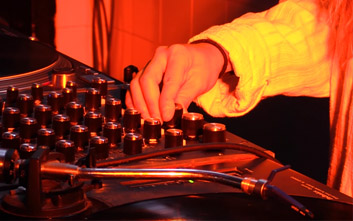A while back, Boiler Room made a follow-up post after Donna Leake played a mix on the program that a lot of listeners didn’t get on with. Faced with an assault on their idea of what Boiler Room is, furious keyboard warriors lit up the comments section, demanding to know why Leake wasn’t a beatmatching, knob-twiddling prodigy.
How dare someone play a set of eclectic musical artefacts? What place have jazz, afrobeat, blues and the sorts of genres that use prefixes like ‘nu’ got on the iconic DJ livestream? What happened to the house – the Berlin techno!?

A electronic music shoots for the same legitimacy as rock and pop, the artistry and harmony of an extended DJ set is still being called into question.
It’s odd that they responded that way – in fact it’s odd the expectations people have of Boiler Room in general, considering the project’s genesis story is tied so closely to the founder of the very online radio station Leake presents her program Brilliant Corners on: NTS Radio.
Undoubtedly home to one of the broadest vinyl vaults in the world, NTS is less well known than it should be for being the place to go when your ears need something fresh.
They’re the palate cleansers of electronic music, and Leake’s set epitomised that philosophy. After all, the ability to weave together often wildly diverse strands into a unique narrative – a set – is one of the most important skills in a DJ’s arsenal.
It’s often underestimated – or perhaps, just misunderstood – the extent to which DJs really play music; not in the cynical sense of pushing play, but in the same sense as a guitarist strums out chords, a pianist weaves melodies over harmonies, and a singer holds a tune.
The DJ is playing a sort of instrument too, time’s just moving slower. Each song fills the role of a single note; it’s got partial meaning on its own, but really takes character alongside another. The way two or more notes interact lead to a more complex character being produced.
It’s a lot like how harmony works, the strange sensation of a real, recognisable and emotional relationship between two notes. What we’re seeing with DJs is a new sort of harmony, synergies between tracks which enable a set to become far more than the sum of its songs.
It’s the ‘Music of Patience’ – a melody taking an hour or more to take shape.
The emergence of the long-form set as a DJ’s native format is a natural product of the way the music has always been listened to. From lugging around cases full of records to plugging a couple of USBs into CDJs, electronic music from techno to trance has always been defined by how it is performed live.
As an aside, this is also probably a leading reason why mainstream coverage of the genre reflects so poorly on the whole: this isn’t a sound that lends itself well to radio edits and singles.
At the same time, many listeners lament the slow death of the album, failing to recognise the rise of something new in its place. The set; an uninterrupted album co-authored by the individual producers and the DJ bringing their ideas together.
Earlier, the Berlin sound was set against the melange of the NTS style, but that wasn’t intended as a slight against either. The German capital is fertile ground for the world’s best, its unfettered, hedonic glee for techno and house giving rise to household names like Pan Pot, Dixon, and Ben Klock.
For every name we in Australia have heard, there must be twenty others over there whose turntables are spinning dark, moody anthems well into the morning. Wielding heavy, metallic, never-heard-by-man sounds, they build industrial soundscapes that echo the dystopic feel of a Fritz Lang film.
It can be creepy shit, but it gets you moving, and your brain bending – for four hours straight, no less.
In the mellower tones of UK electronic, artists like Bonobo and Four Tet have tried to own the set-narrative idea, having a dig at performances in a more sophisticated, formal setting.
Both have torn down the Sydney Opera House with incredible shows. Four Tet’s innings was presented with a virtuoso’s force: beginning from near silence it swelled to an epic rush of energy, before easing back down to its original calm.
Bonobo evidently justified his own artistry, with one review claiming “his solitary time on stage proved that he is the central mastermind, moulding and reshaping the sounds he has already created, giving them a renewed focus, cohesion and potency.”
Consciously billing themselves as song-selectors meant that the quieter, less active moments of their sets are as important and interesting as the more conventional bass-beat driven tunes.
In recent times, the long-form performance has found a new platform that’s enabled it to succeed away from the stage: the podcast. Not only that, but podcasts have started to take on unique characteristics of their own that allow them to achieve more than just an echo of a live show.
Without the need to keep the listener dancing, excited and 100 percent engaged, many DJs have found they can let a more introspective, progressive feel into their online sets that enhance the storytelling aspect of the music.
The appropriately named Tale of Us, who’ve shot to fame in recent years, recently premiered a new series Afterlife Voyage to debut material from their Afterlife imprint. The first episode is an atmospheric, mysterious journey which, to be frank, is leagues ahead of the live sets they’ve offered up in Sydney, which for a range of reasons (some outside their control) haven’t quite maintained the same level of engagement.
Meanwhile, some people just desperately need to groove. The modern trope of DJs as rockstars has led to a bizarre state of affairs. DJs, flanked by a wall of lights and speakers, facing an audience who face back, waiting to watch… fistpumps? Eager leaning and dramatic knob-twisting? Thanks, Steve Aoki.
Meanwhile, James Murphy of LCD Soundsystem is collaborating with the boys from Soulwax/2manydjs to put together a concept show that’s turning the paradigm on its head.
Encircled by eight speaker stacks, the DJs hidden away from clear sight, Despacio lets listeners get in their own space, and wriggle it all out. This vinyl only temple of hi-fi means that rather than waiting around for the next drop, the audience listens according only to their own ears, getting excited by what excites them, not rockets of smoke or a blast of cheap fireworks.
As a private little touch on the music they’re borrowing, the music’s spun around 6-10bpm slower than the original mixes, just to drop in a special, ethereal character to the experience.
A DJ friend who experienced Despacio at Coachella ‘16 insisted that the next time it got brought anywhere in the APac Region, we’d have to find a way to be there.
Leake’s eclectic sound was justified from the outset as an interesting palette of sounds that came before, and consequently affected, electronic music. She played the bones on which more modern electronic grew as flesh, and it’s an awesome experience to listen with that context in mind, and notice relationships between old and new that might otherwise have been missed.
But even without that, Leake, and countless others, are great DJs not because they aspire to the technical mastery of a Pioneer product, or because they drop the heaviest, ear-driller drops.
The best DJs are musicians, using their own special means to tell a story with great track selection, audience sensitivity, and independent flair. That’s the true source of their legitimacy as artists.



